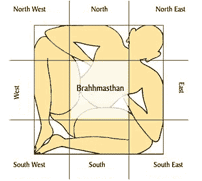VASTU SHASTRA

> Shilpa Shastra , Buddhism & Influences<
> Vedic Astrology and Vastu Shastra <
“The vastu-purusha-mandala represents the manifest form of the Cosmic Being; upon which the temple is built and in whom the temple rests. The temple is situated in Him, comes from Him, and is a manifestation of Him. The vastu-purusha-mandala is both the body of the Cosmic Being and a bodily device by which those who have the requisite knowledge attain the best results in temple building.” (Stella Kramrisch,; The Hindu Temple, Vol. I)
Vastu Shastra (vÄ�stu śÄ�stra, also Vastu Veda, „science of construction“, „architecture“) is a traditional Hindu system of design based on directional alignments. It is primarily applied in Hindu architecture, especially for Hindu temples, although it covers other applications, including poetry, dance, sculpture, etc. The foundation of Vastu is traditionally ascribed to the mythical sage Mamuni Mayan.
Manasara and Mayamata are the standard texts on Vastu Shastra, and they codify the theoretical aspects of all types of constructions; but specifically of temple construction. These texts deal with the whole range of architectural science including topics such as soil testing techniques, orientation, measures and proportion, divination, astrology and ceremonies associated with the construction of buildings.
The ancient Indian text Mayamata, written thousands of years ago, describes Vastu Sastra – the science of ancient Indian architecture. Hindu mythology explains the history of how it all started.
Vastu Sastra is both a science and art and its purpose is to make a human habitation not only a thing of beauty and strength but also make it give delight and affluence to the inhabitants in the long run.
Vastu Sastra, apart from being the science of architecture, can also be called the science of energies. The cosmic energies are converted into material benefits for the residents of the Vaastu-based structure and in a way, Einstein’s Theory e=mc2 is reflected in this ancient science. It converts living spaces to an order that sets an equation between the cosmic energies and the people living in the building to ensure physical, spiritual and material well-being. Vaastu creates a rhythm and balance in a building or a layout of a town to ensure a qualitatively better life for the residents.
Although deeply concerned with the Panchamahabhootas or the five primary elements of Nature viz., earth, water, fire, wind and space, and their balancing, it takes into cognizance the various other known and unknown cosmic energies. We understand these energies and try to harness their good influences on human life by a methodical placement of doors and windows, rooms, hearths and ovens, water bodies, open space in and around a building etc.
Experiment, observation and inference were the main criteria of arriving at the truth. However, the additional tool that a wise scholoar should have, is the intuitional perception with which many disciplines of knowledge developed. Various energies run around us in a particular pattern which can be harnessed such that they resonate with the individual being or the people residing in the building in a good manner to make their lives meaningful and harmonious. Various creative, destructive and sustaining energies present in the cosmos are considered and a set of guidelines are given for planning a site, a building, a layout or even a town that which is eco-friendly and contributes to the comfort and contentment of the habitants.
> Meet VASTU, Friends, and Study Groups at facebook <
Comments are closed.